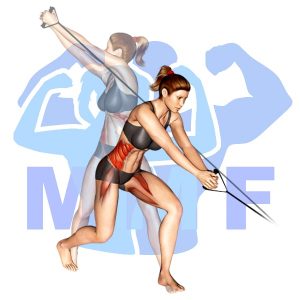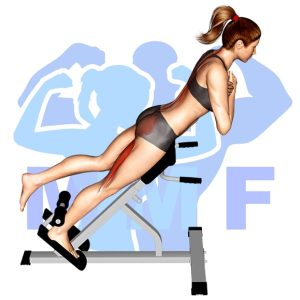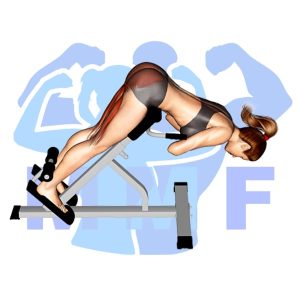If you’re tired of doing endless reps of traditional abdominal exercises without seeing the desired results or if you’re someone who suffers from lower-back pain due to long periods of sitting, we understand how frustrating it can be. That’s where resistance band pull down standing twists come in. Many people experience lower-back pain because they lack core muscle strength or because they sit for extended periods of time. Incorporating resistance band pull down standing twists into your workout routine can help build core strength and alleviate lower back pain. In this blog post, we’ll discuss the benefits of incorporating resistance band pull down standing twists into your workout routine and how to do them properly, so you can experience a stronger core and a pain-free back.
Resistance Band Pull Down Standing Twists Summary
- Primary Muscles: Obliques
- Secondary Muscles: Adductors, Gluteus medius, Gluteus minimus – anterior fibers, Iliocastalis lumborum, Iliocastalis thoracis, Psoas major, Quadratus lumborum, and Tensor fasciae latae
- Equipment: Resistance Band and Door Anchor
- Mechanics Type: Isolation
- Force: Pull
- Utility: Auxiliary

Resistance Band Pull Down Standing Twists Instructions
- Anchor the bands to a point as above your head. Then, grasp the handles together with both hands.
- Step and turn your lower body away from the anchor point. Your arms should be reaching back up and behind you with your body twisted. Position your feet facing away from and to the side of the anchor point.
- Next, place your foot furthest further away from the anchor point in front. Raise the heel of your back foot off the ground slightly.
- Now, Keeping arms straight, rotate torso and bend forward to the other side until the band makes contact with your shoulder.
- Finally, untwist and return to starting position.
- Repeat your twists for 8-12 reps.
Video Tutorial
Resistance Band Pull Down Standing Twists Muscles
Target (Agonist)
Synergists
- Adductors
- Gluteus medius
- Gluteus minimus – anterior fibers
- Iliocastalis lumborum
- Iliocastalis thoracis
- Psoas major
- Quadratus lumborum
- Tensor fasciae latae
Dynamic Stabilizers
- None
Stabilizers
- Deltoid – Posterior
- Erector Spinae
- Latissimus Dorsi
- Pectoralis Major – Sternal
- Pectoralis Minor
- Rectus Abdominis
- Rhomboids
- Teres Major
- Trapezius – Lower
- Trapezius – Middle
- Triceps – Long Head
Antagonist Stabilizers
- None

Benefits of Resistance Band Pull Down Standing Twists
Performing the Resistance Band Pull Down Standing Twists in a strength training or fitness routine helps to target the obliques, which are the muscles located on the side of your abdomen. This exercise helps to build muscular strength and endurance in the obliques, allowing them to better support the spine and aid in everyday activities such as bending and twisting. Additionally, this exercise helps to promote improved posture by strengthening the core muscles. Furthermore, as the oblique muscles are engaged throughout the entire range of motion of the exercise, it helps to increase mobility in the lower back and hips.
Tips for Performing Resistance Band Pull Down Standing Twists
In order for you to get the right improvements, adhere to these basic tips. Similarly, if you need to minimize the chance of injuries, stick with these tips.
- Complete The Correct Quantity Of Sets With Rest. Your goal initially ought to be to do 3 sets to near fatigue. However, you can raise to 5 sets. If your muscle tissue isn’t exhausted at the end of 3 – 5, something needs to change. Initally, you can increase the resistance to make each rep harder. Next, you can cut down on the rest time between each set.
- Make Use Of A Mirror To Check Your Form. You may think you are a little vain looking in a mirror when you are doing exercises, but you are not admiring yourself, you are insuring your form is effective.
- Slow Each Rep Down For Improved Strength Gains. By Raising the time under tension you are engaging your muscles more and they will respond by gaining strength. You can achieve this without raising the resistance by slowing down you reps roughly 4 – 6 seconds flexing and pause then 4 – 6 seconds relaxing.
Benefits and Tips Video
Frequent Mistakes To Avoid
You must keep from doing these fairly typical mistakes to have ideal form and reaching your goals. As well
- Don’t Allow Yourself To Cheat. In most cases, cheating is employing momentum as a substitute for the strain of your main muscle tissue. Once in a while, a little cheating on your last rep can be beneficial to overload your muscle, but not for more than a handful of reps.
- Don’t use To Little or Too Much Tension. Too little, and you will not be sufficiently using your main muscle, excessive, and it will lead to cheating. Make sure you can do between 8-12 reps with good technique.
Find More Resistance Band Exercises Here
Variations and Complementary Exercises
If you’re looking to switch up your workout routine and are looking for some alternative exercises that work similar muscles as the Resistance Band Pull Down Standing Twists, look no further! Below is a list of variations, complementary, or alternative exercises that you can incorporate into your workout.
Resistance Band Standing Twists

Resistance Band Standing Twists is a great complementary or alternative exercise for the Resistance Band Pull Down. This exercise requires the user to stand with their feet shoulder-width apart and hold the band in both hands at chest height. The user then twists their torso from side to side, pulling the band taut as they go. This exercise targets the core muscles, obliques and shoulders, and can provide a great workout for those who are looking to strengthen their midsection or just give their core a break from the traditional resistance band pull down exercise. It can also be a great way to mix up your routine and keep your muscles guessing!
Resistance Band Side Crunch

The Resistance Band Side Crunch is a great complementary exercise to the Resistance Band Pull Down Standing Twists. This exercise targets the oblique muscles and helps to improve core strength. The Resistance Band Side Crunch is an alternative to traditional crunch exercises, as it engages the obliques more than other core exercises. It is also an effective way to improve posture and balance, as it works the side abdominal muscles that help to keep the body upright and stable. It can be done with a resistance band tied around a sturdy pole, or it can be done by looping the band around the feet and grabbing onto the handles while lying down.
Resistance Band Side Bends

Resistance Band Side Bends are a great complementary or alternative exercise for Resistance Band Pull Down Standing Twists. This exercise targets the obliques and helps to strengthen the lateral muscles in the core, which is often neglected in most core exercises. To perform Resistance Band Side Bends, stand with feet hip-width apart, hold one end of the resistance band in each hand with palms facing down and arms extended straight out at shoulder level. Slowly bend from side to side, using your obliques to pull the band. This exercise helps to improve balance and strengthen the core muscles.
Check Out These Top Resistance Band Exercises
Resistance Band Pull Up Standing Twists

Resistance Band Pull Up Standing Twists is an exercise that is complementary to Resistance Band Pull Down Standing Twists. This exercise is a great alternative for those who may not be able to do a traditional pull-up. The Resistance Band Pull Up Standing Twists is performed by attaching a resistance band to a sturdy object and then grabbing the band with both hands. The user then pulls the band up, twisting their torso as they pull, and bringing the band down again. This exercise strengthens the back muscles and core while also providing a great stretch for the shoulders and chest. It is a great alternative to Resistance Band Pull Down Standing Twists as it provides a unique twist on the traditional pull-down exercise.
Oblique Crunch

The oblique crunch is a great exercise to complement or substitute for the resistance band pull down standing twists. This exercise targets the obliques and core muscles while still engaging the shoulders, chest, and arms. The oblique crunch requires you to lie on your side and raise your torso up while keeping your hips and legs still. This exercise can be performed using just bodyweight or with additional resistance to increase difficulty. It is an excellent way to strengthen the core and obliques, and provides an effective alternative for those who may not be able to perform the standing twist exercise.
Legs Up Twist Crunch

Legs Up Twist Crunch is a great complementary or alternative exercise to Resistance Band Pull Down Standing Twists. It works the core and oblique muscles while also engaging the upper back and shoulders. To perform this exercise, start by lying flat on your back with your legs in the air and your knees bent. Then, twist your torso to one side while contracting your core muscles. Pause for a few seconds and then twist to the other side. Make sure to keep your legs in the air throughout the entire exercise. This exercise helps to increase core stability and strengthen the obliques, making it a great addition to any resistance band workout.
Find More Abs Exercises Here
Opposing Complementary Exercises
To further round out your workout, incorporate these exercises into your routine to target opposing muscle groups. By doing this, you’ll be able to target all the muscles involved in the Resistance Band Pull Down Standing Twists exercise and help ensure proper balance in your body. Here are some exercises that you can do to complement the Resistance Band Pull Down Standing Twists:
45 Degree One Leg Hyperextension

The 45 Degree One Leg Hyperextension is a great complementary exercise to the Resistance Band Pull Down Standing Twists as it works the opposing muscle group. It targets the lower back, glutes, and hamstrings to help build strength and stability in those areas. This exercise can be done by placing your feet on an elevated surface with one foot on the floor, then using your lower back, glutes, and hamstrings to lift your body up and down. This is a great way to strengthen the muscles that are used in the Resistance Band Pull Down Standing Twists and help create a balanced body.
45 Degree Hyperextension

The 45 Degree Hyperextension is a great exercise to complement the Resistance Band Pull Down Standing Twists, as it works the opposing muscle group. This exercise targets the lower back and glutes by having you lie on a bench at a 45-degree angle and then extending your hips up towards the ceiling. By focusing on the lower back and glutes, the 45 Degree Hyperextension helps to offset the intense focus on the arms and shoulders with the Resistance Band Pull Down Standing Twists. This balance of exercises allows you to target the opposing muscle groups while still getting a full body workout.
Straight Leg Cable Pull Through

The Straight Leg Cable Pull Through is an excellent complementary exercise to the Resistance Band Pull Down Standing Twists. This exercise strengthens the posterior chain, which includes the glutes, hamstrings and lower back muscles. The Straight Leg Cable Pull Through activates the opposing muscle group of the Resistance Band Pull Down Standing Twists, which primarily focuses on the core and upper body muscles. By completing both exercises, athletes can achieve a balanced workout that focuses on all of the major muscle groups in the body.
Transform Your Core: Try the Resistance Band Pull Down Standing Twists Today!
Are you tired of doing endless crunches and sit-ups to try and strengthen your core? Why not give the Resistance Band Pull Down Standing Twists a try? This exercise is a great way to engage multiple muscle groups in your core and increase your stability and balance. You’ll need a resistance band for this exercise, but it’s worth the investment to add some variety to your routine. Mix up your workout and try something new by incorporating the Resistance Band Pull Down Standing Twists into your next session.
References: Wikipedia | ExRx.net | PubMed.gov | Comprehensive List of Abs Resistance Band Exercises

